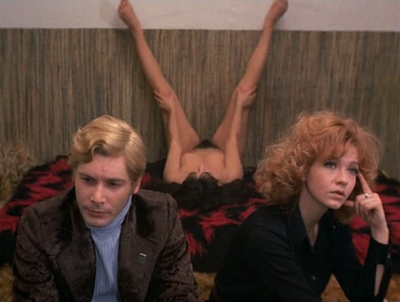On Godard’s Masculin/Feminin

(Now? The SI?) For many still overawed by the pronouncements of the Situationist International the names of Jorgen Nash and Jean-Luc Godard ring out as benchmarks of counter-revolutionary cultural activity. Godard, the darling of the Nouvelle Vague and regular contributor to Les Cahiers de Cinema, came in for an especially strong dressing-down.Yet when you return to these passages from the mid 60s what is striking is the flimsiness of the so-called critiques. What the anonymous author of The Role Of Godard and Cinema & Revolution seems to be rejecting is not the films themselves but their reception in the media and the academy. Deeper research may reveal that Godard was in collusion with such a reception and that he may have been inspired by the films of the SI, but the SI nonetheless reveals itself, in the former article, to be in collusion with the dictates of high art when, in affording Godard “the consistent expression of a subjectivity” they qualify this as a “subjectivity on the level of a concierge educated by the mass media” (1). In the latter article Godard is contradictorily berated as being “not even … capable of the slightest personal originality” (2). So, in their impatience to denounce Godard, the Situationists drop their guard to reveal not only a class snobbery, but an assessment of culture as a site of competing individualities and not as that which can destabilise our idea of individuality. Moreover, as revolutionaries attacking a bourgeois culture which is for them epitomised by Godard’s pseudo political stance in such films as Masculin/Feminin, they do not take cognisance of how their falling back on such a notion as ‘personal originality’ in their ‘critique’ of Godard is precisely to mobilise the very lynchpin of bourgeois culture they want to be seen to be attacking.
This problem of ‘originality’ was one that the Situationists were keen to overlook. The practice of detournement, whilst ostensibly resolving this problem, is one that, in re-appropriating imagery and ideas, does not do away with the misleading status of ‘possession’. That Situationist texts are littered with denouncements of theorists and practitioners whom they drew upon and then claimed to have surpassed may be a point in case. Such manoeuvres, untroubledly legitimated by the SI’s self-appointed status as a revolutionary organisation, have the aftereffect of accruing to themselves the status of ‘originators’ rather than participants in the culture they sought to overthrow. Thus, in the Cinema and Revolution article the anonymous author – presumably Guy Debord – announces himself in the third person as beginning work on a film version of the Society Of The Spectacle. We are to presume from the tone of the article that this work will be a true original; indebted as it is to Eisenstein’s project to make a film version of Capital. But even though Debord’s work is a polemical tour-de-force of roughshod innovation, a film that is unafraid to institute its own form, it is a film that seems to flounder on its own reputation. It is outside the canon but forms its own canon wherein its director becomes the ‘possessor’, the arbitrative filter, of both the theory and the images. In this way the film falls foul of the last sentence of Thesis 108: “Detournement has grounded its cause on nothing external to its own truth as present critique” (3). Watching the Society Of The Spectacle we are witness to the tragedy of one man taking-on the historical dynamic of capitalism in the name of a class that he once forgot himself enough to insult. Is it such a pervasive atmosphere of loneliness that makes Debord’s film work against itself or is that, in increasingly coming to freeze its position as a premeditated ‘truth’, it seeks to freeze a continually moving social practice until any defence of such a ‘truth’ becomes filled with a moralistic nostalgia? The Society Of The Spectacle, as a manifesto which indicts an heteronomous society from the impossible and idealistic position of complete autonomy, comes to surmount the contradictions of practice that were to become increasingly central to a ‘cultural sphere’ that Debord and the Situationists rejected. And so, it is no surprise that Debord’s disgust for Godard comes into sharpest focus when the latter uses popular cultural themes in his work: “His flaunted culture is largely the same as that of his audience, which has read exactly the same pages in the same drugstore paperbacks” (4). This disdain for popular culture and the ‘low’ arts as the products of a spectacular economy is what assures Debord his aloof separation from society: he disqualifies himself from the contradictory ground of practice and alienates himself from any common fight for autonomy that does not seek to conform to the ‘truth’ of Situationist theory. Godard on the otherhand, choosing a spontaneity that makes him receptive to contradiction and to the social relations that surround him, may not know what he is doing beforehand, but he at least ensures that the outcome is one that does not burden possible action with the moralism of ‘unrealizable injunctions’. Godard’s interest in popular culture, from the gangster films and westerns that he reviewed for Cahiers de Cinema to the rise of the pop industry and the counter culture, did not, as the Situationists suggest, compromise his politics, but made them somehow more elusive and paradoxical, more liable to be transmitted through the culture than those of Debord and the SI. In the long run they are a politics that we can see evolving and which do not discount the role of the imaginary, the absurd and the creative, but bring these in to political practice as necessary components of any movement towards social change. Whereas Debord assaults us with a ‘truth’ we have to accede to, with an offer of being disciple to his master, Godard, it seems, takes more risks with being imperfect, contradictory and inconsistent. He doesn’t shy away from being pretentious and exploratory and therefrom opens up the terrain between the screen and the spectator which Debord, in cinematically illustrating the ‘truth’ of his own theory, makes even more unbridgeable. The latter, by establishing an heteronomous relationship of passive dependency between himself and his audience seems to ensure that he expresses the ‘spectacle’ in his own practice and brings along with this an active disdain of our own ‘idiolectic’ potential to be more participants than spectators. If such closure and hermeticism as that of Debord’s is revolutionary then the Society Of The Spectacle is a revolutionary film and Godard, throughout all his works, was pampering to the public taste of imbecilic concierges.
But what exactly is a ‘revolutionary film’? [Read more →]
As we did a year ago we look at which articles were the most read ones of the past year (online):
2012 was the best year for datacide online so far with the most views/reads and November 2012 was the best month in the history of the site since it was launched at the beginning of 2009 (replacing the old archive site and the temporary blog). Considering that datacide 11 came out in February 2011 and the next issue only in October 2012 and, connected to that, the fact that only very little material was posted during 2012 (19 posts) this is a really good result. It shows that more people find out about the magazine and the rich archive of articles besides the new additions. It’s not surprising that most articles read online in 2012 were from issue 11 or earlier as the majority of texts from number 12 are not even online yet and the ones that are were posted in November or December.
1. Dance before the Police come by Neil Transpontine (from Datacide 11). This one shot up in the statistics when a Guardian article by Dan Hancox from last July linked to it. But it was much read before then, having already been at number 6 of the most read articles of 2011, obviously touching on one of the key themes of datacide.
2. You’re too Young to Remember the Eighties – Dancing in a different time by DJ Controlled Weirdness (from Datacide 10) A slow burner that has attracted a lot of readers over the last year, becoming one of the most read articles on the site, despite – as far as we can tell – not being linked to from any “prominent” sites. Nice.
3. Dope smuggling, LSD manufacture, organised crime & the law in 1960s London by Stewart Home (from Datacide 11), up from number 9 of the previous year’s most read. This is also the article version of Stewart’s talk at the 2008 datacide conference in Berlin.
4. COIL – Interview from 1986 plus Introduction by Christoph Fringeli/John Balance. Being linked to from Wikipedia and the official Coil site this is the most read post on datacide attracting a steady readership. Somewhat ironic considering the interview was done over a decade before datacide started before it was re-published in issue 9 (incidentally the issue with the lowest print run of datacide).
5. From Subculture to Hegemony: Transversal Strategies of the New Right in Neofolk and Martial Industrial by Christoph Fringeli, which was the most read piece in 2011 (from Datacide 11). Of course we are wondering who reads this and related articles – Anti-Fascists? Fans of industrial music? Fans of Evola or Jünger?
6. WE MEAN IT MAN: Punk Rock and Anti-Racism – or: Death In June not Mysterious. Stewart Home’s article on Death In June from Datacide 7.
7. What the Fuck? – Operation Spanner by Jo Burzynska from Datacide 2 – and thus the oldest article originally published in Datacide in this list. Was already number 7 in the 2011 chart. Many visitors seem to be coming from Clarisse Thorn’s blog.
8. The Brain of Ulrike Meinhof by Christoph Fringeli from Datacide 9, last year’s number 8 as well.
9. Shaking The Foundations: Reggae soundsystem meets ‘Big Ben British values’ downtown by John Eden from Datacide 11, the second most read article of 2011 still receiving a fair amount of hits.
10. “LONG LIVE DEATH” – on Pasolini’s Salo by Howard Slater from Datacide 6 and one of his brilliant film reviews which also include an article about John Carpenter, the Western and others.
11. Communisation theory and the question of fascism by Cherry Angioma, already a much discussed and re-blogged post from the latest issue, Datacide 12, addressing important issues of the current debates in the communist movement.
12. The Dog’s Bollocks – Vagina Dentata Organ and The Valls Brothers (Interview) by John Eden. Exclusive interview with Jordi Valls that comes second in the only recently posted articles from the latest paper issue, and will no doubt be a contender along with “Communisation Theory…” for the 2013 charts…
Of course we know that by posting this list there will be a tendency that those article will be read again while others that would also be worth a read might be overlooked. Hence here some more or less random links to other articles with the explicit invitation to investigate further by browsing the site:
E.g. the classic Post-Media Operators by Howard Slater/Eddie Miller/Flint Michigan from Datacide 2, or its follow-up text Post-Media Operators – Sovereign & Vague from Datacide 7. Or what about Matthew Hyland’s New Age Policing – Biology is Ideology from the same issue, or maybe The World Made Flesh by Matt Fuller from Datacide 8…?
There are now nearly 300 articles on this site, and the next print issue is being prepared. We have a lot of plans for the future. You can help us realising them sooner rather than later by making a donation or taking out a subscription for 3 issues for 10 euro. Write to (or paypal funds to) datacide(at)c8.com


WR: Mysteries of the Organism
(Directed by Dusan Makaveyev, 1971, English and Serbo-Croation with English Subtitles, 85 minutes)
16 December, 20 Uhr @ Cagliostro / Praxis Shop – Lenbachstr. 10 Ostkreuz, Berlin
Datacide presents the screening of “WR: Mysteries of the Organism” at Cagliostro on 16 December at 20,00. Originally titled “WR (Wilhelm Reich): Mysteries of the Orgasm”, this subversive critique was shown only at a few cinemas in Yugoslavia in 1971 and then banned. This forced the director to emigrate in order to continue his relentless critique of Marxist-Lennism, traditional sexual politics and all anti-liberatory tendencies of the Cold War era. “WR” masterfully uses collage filmic technique to interlace documentary, fictional and found footage together into a combative story on Reich’s sexual politics. The collage techniques shock the viewer and instigating critique at every level. Datacide (C. Fringeli and Nemeton) will make a short introduction and a discussion with the viewing audience at the end of the film to highlight some of the aesthetic and political issues.

The feature length film “Saila” by Julia Ostertag situates in the industrial ruins of East Berlin a visceral enactment of post apocalyptic terror. The remnants, both broken people and destroyed environments, after the near end of the world are never given a reason for continued life, nor is it ever specified what catastrophes coalesced to become everyday life for the film’s protagonists. “Saila” can be viewed as an experimental project that attempts to critique film as a visual medium and standardized genre by doing away with traditional narrative strategies such as linear character development and causal storytelling. [Read more →]
‘If you ask for my life, I will stab you in the heart’
1.
Four black and white camera angles show a subway station; no sound. A train arrives, people get on and off. The lights of the next train shine from the tunnel. An agitated man descends onto the tracks. His final moments are recorded in monochrome, 15 frames per second, 13, 14, 15.
In 2006’s “The Description of Bankruptcy”, director Lee Kang Hyun carries forward the haunting violence of this moment, the despair in the jumper’s anonymous fate and the events which would compel it in order to provoke reflection on the financial crisis of 1997 and its aftermath. Images of Seoul are overlapped with radio channel chatter, news reports stream lifestyle advice atop cityscapes. We are taken from one scene to another. Everyday life goes on in industrial spaces; a printing press rapidly stamps paper. Traffic passes through Seoul: ‘People who don’t smile a lot have wrinkles in their face’, a stone-faced man stacks papers in a printing machine, his gloves stained red. ‘…smile out loud as much as you can. One who smiles a lot also has less chance for mental illnesses such as hypochondria.’ Other workers steam-press clothing in a factory with the radio confidently declaring: ‘The time has come when all power comes from the people, as stated in the Constitution article 1.’ We are not given any cues to celebrate. Steam rises from the cloth.
[Read more →]





